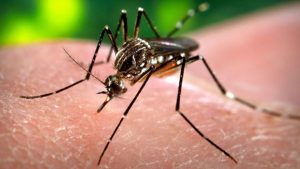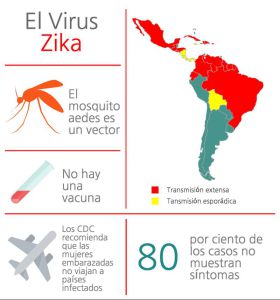“I had spots on my skin and my sister had them too. At first, we thought it was an unknown allergy,” Rodriguez said in an interview in Spanish. “My doctor in El Salvador told me that it was not a serious problem, and that I should look for other ailments upon my return.”
Although Rodriguez and her doctor dismissed the rash at first, her mother became concerned when she felt ill after her return to the United States in January. Rodriguez had a fever, pink eye and fatigue –– symptoms of the Zika virus.
In the past few months, the Zika virus has spread rapidly through Central America, South America and the Caribbean Islands, with more than 20 countries in the Americas reporting outbreaks. The World Health Organization (WHO) declared the Zika epidemic a global emergency Feb. 1–– a global emergency has only been enacted three times previously.
Rodriguez learned about the virus from her family in El Salvador. When she learned of the virus, she visited her doctor and he told her that she her that she had likely been infected with Zika. Although she was not tested for the virus in the laboratory because she had already recovered, her symptoms aligned with those of Zika.
“I called my family in El Salvador and it turned out that my cousin in the house in which I was staying had the same symptoms as me,” Rodriguez said. “They learned about Zika before us. They were the ones who told us what was going on.”
Zika causes fever, sore muscles and head pain. However, 80 percent of people who contract the virus do not show symptoms, according to the Centers for Disease Control and Prevention (CDC). The virus naturally leaves the bloodstream after a week, but currently there is no cure. Scientists are currently working on one.
Rodriguez has since recovered from her illness in January.
Although there are few serious or fatal reactions to Zika for a majority of the global population, there can be dangers for pregnant women, according to the WHO. Growing evidence has linked the Zika virus to serious birth defects such as microcephaly, in which an infant’s skull circumference is unhealthily small and the brain is underdeveloped. The CDC recommended that pregnant women do not travel to infected countries.
In May 2015, the first transmission of Zika in South America was reported in Brazil.
When the WHO declared a state of emergency, the CDC was permitted to give resources to developing countries that lack an infrastructure to support advanced public health, according to Marin County Public Health Officer Dr. Lisa Santora.
“That allows us to send personnel and infectious disease control to countries that need help,” Santora said.

International leaders have taken extensive measures to combat the spread of Zika. President Obama requested $1.9 billion from Congress to control the spread of the virus on Feb. 22, while Pope Francis suggested that contraceptives are acceptable to slow the spread of Zika and its effect on infants. The El Salvadoran government took more radical measures, requesting that women not get pregnant until 2018.
On Feb. 8, the CDC increased its Emergency Operations Center to the highest level after activating it on Jan. 22, which means that it will accelerate preparation measures to combat a possible future outbreak in the United States.
The government agencies are not only helping outside nations but also protecting Americans by taking actions to prepare for a potential American Zika outbreak, according to Santora.
“In Marin County already we have some things in place to protect the security of our population, especially related to emerging infectious diseases,” Santora said.
The Marin-Sonoma Vector Control District monitors for vectors such as mosquitoes, and educates travelers who visit infected regions on the necessary protections, according to Santora.
“Marin has a population that has emigrated from the area-––Brazil and other South American countries––where the Zika virus has been established,” Santora said.
Junior Lindsay Thornton, who went to Colombia in February, said she researched techniques to prevent infection before her trip.
“I saw the warning that the United States give to travelers, so we are going to take precautions. We will use insect repellent and wear loose clothing,” Thornton said before her trip.
Although travelers can get Zika from other regions, the virus cannot be transmitted by mosquitoes in Marin because the species cannot survive in Northern California, according to the Department of Public Health in California.
The Aedes mosquito, an invasive species to California, is responsible for the spread of Zika. The species prefers tropical climates and can be found in Southern California because the weather is warm most of the year, according to Santora, but scientists do not predict a large outbreak in most areas of the United States. There are currently no local transmissions of Zika in the continental United States, aside from 14 reported incidents of sexual transmission.


















